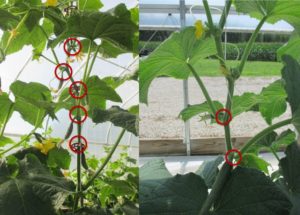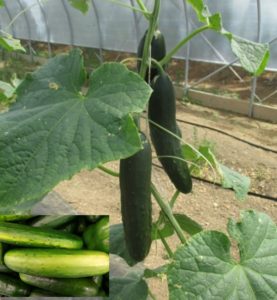Cucumbers are produced with very different production systems. The ideal cucumber variety for process pickling production is not the variety used for greenhouse production. Choosing the suitable variety for a specific production system then becomes important.
Where do you find recommended cucumber varieties for high tunnel production in seed catalogs? Some of the seed catalogs have a category called Greenhouse or Protected culture. Varieties listed in this category are recommend for greenhouse or high tunnel production. Other seeds catalogs may call this group Parthenocarpic hybrid or European slicer. Cucumbers listed under these names are also suitable for greenhouse or high tunnel production.
A few technical words (parthenocarpic, monoecious, gynoecious) occur frequently in the descriptions of high tunnel-grown cucumbers. Understanding their meaning is important in choosing the right varieties.
Parthenocarpic means that the plant can set fruit without pollination. Since pollinators are not required in this case, parthenocarpic is a desirable characteristic for cucumbers grown in protected cultural system. Cucumbers are harvested in immature stages where mature seeds have not developed yet. However, it is not uncommon to see immature seeds in field-grown slicer cucumbers. Consumers prefer cucumbers without seeds. Cucumbers produced by parthenocarpic plants are seedless, which is another reason that parthenocarpic cucumber plants are preferred for growing in greenhouse/high tunnel situations.
Monoecious and Gynoecious describe flower patterns of cucumber plants. Monoecious plants produce both male and female flowers in a single plant, while gynoecious plants produce primarily female flowers. Since female flowers are produced at every node of the gynoecious plant, gynoecious plant normally has a higher and earlier yield compared to monoecious plant (Figure 1).

Figure 1. There is a cucumber fruit developing at the node marked with red cycles. The cucumber plant on the left is a gynoecious type plant, note it has cucumbers on every node. The cucumber plant on the right is a monoecious plant, note there are no cucumbers on the top two nodes.
Different types of fresh-consumed cucumbers. The most commonly grown type of cucumber is the American slicers. Although the majority of American slicers are grown in open-field. A few varieties are parthenocarpic and gynoecious that are well adapted for growing in greenhouse/high tunnel situation. When cucumber plants are trellised, they do not have a yellow belly that is often observed on field grown slicer cucumbers (Figure 2).

Figure 2. Well colored cucumbers on a trellised plant grown in a high tunnel. The cucumbers do not have yellow belly as shown on cucumbers at the left bottom of the picture.
European or English type cucumbers and Beit alpha cucumbers are originally bred for greenhouse production. The majority of the varieties in these types are parthenocarpic and gynoecious, they are more suitable to grow in a greenhouse than in an open-field. European type cucumbers are normally 14-16’’ long, they are individually wrapped. Most Beit alpha cucumbers are about half of the size of European cucumbers. Beit alpha cucumbers can also be harvested smaller, and be sold as mini-cucumbers. Both European and Beit alpha cucumbers have thinner skins compared to American slicers. They do not need to be peeled which adds extra green color to the dish and it is preferred by consumers. Both European type and Beit alpha type cucumbers sell at premiere price in the market. This is particularly true for European type cucumbers whose long shape makes it easy to be distinguished from slicer cucumbers.
Another group is called Asian or Japanese type cucumbers (Figure 3). They produce long, slender, thin-skinned cucumbers, similar to the European type cucumbers. Asian type cucumbers are not originally bred for greenhouse production that might explain why they are generally tougher and earlier to grow than European type cucumbers. Another advantage of the Asian type cucumber compared to European type cucumber is that they are less likely to produce misshaped fruit if they are pollinated, which could happen in semi-opened high tunnel situation. Some of the Asian type cucumbers are parthenocarpic that are well adapted to greenhouse/high tunnel production, however, the majority of this type of cucumber plants is monoecious producing both male and female flowers.
Seed cost. Seed cost is one of the important considerations in choosing cucumber varieties grown in high tunnels. The price of parthenocarpic cucumber seeds varies dramatically among different types. The most expensive seed is the European type cucumbers, seed cost could be as high as $1 per seed. Seed price for Asian type cucumbers is the lowest, less than $0.1 per seed. Seed price might not be a big concern if one cucumber plant can continuously produce for three months or longer, but if the plants died from diseases after producing only for a few weeks, and then require replanting, seed cost would be an important consideration in the decision of choosing cucumber varieties for high tunnel production.
In summary, when choosing seedless cucumbers to be grown in high tunnels. Yield, fruit quality, consumer preference, and seed price should all be considered. Another important factor is disease resistance that we will discuss in the future articles.
This project is supported by NC-SARE under project number LNC17-390 ‘Improving Seedless Cucumber Production to Diversity High Tunnel Crops in the North Central Region‘.
